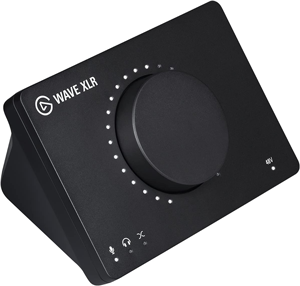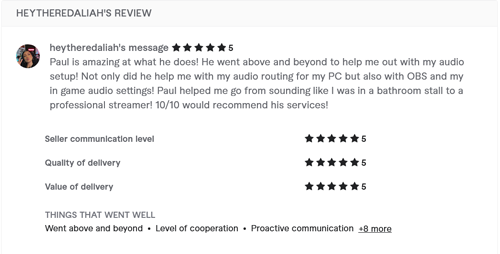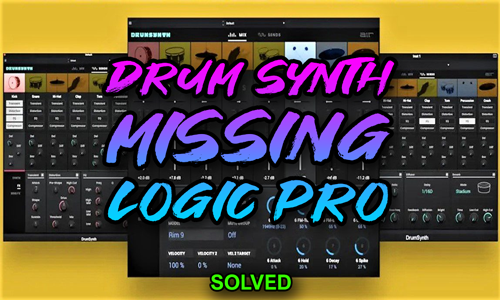- Client: HeyThereDaliah, Twitch Streamer, USA
- Date: 10th June 2025
- Remote Connection: Whatsapp Voice (phone call) and Anydesk (remote desktop)
The Challenge:

A client, a gaming streamer with the username HeyThereDaliah on Twitch, was experiencing audio issues with her Elgato Wave Link audio interface. Her microphone was not being picked up by OBS for her stream, nor by her in-game chat (specifically within GTA V’s FiveM container). This significantly hindered her ability to create content and interact with her audience.
The primary hurdle was correctly configuring the audio routing options within the Elgato Wave Link software, which includes a virtual mixer and VST effects. Additionally, the client needed to ensure her earbuds, plugged into the Wave Link’s headphone jack, were functional as a Windows playback device, and that her microphone with effects was correctly routed to both OBS and her game.
The Solution:
After the client reached out, we arranged a remote support session for the next day. I connected with the client via a phone call and used AnyDesk for the remote desktop connection, allowing me to diagnose her audio configuration problems.
- Enabling Headphone Output: My first step was to address the client’s inability to hear audio through her Wave Link headphones. I navigated to Windows Sound Settings, then to the advanced properties for the Elgato Wave Link device. I found that the headphone output was disabled as a playback device. Enabling this allowed it to be selected as the default sound option in Windows, and a quick test with a YouTube video confirmed audio was now playing through her earbuds.
- OBS Microphone Input Configuration: With the headphone output resolved, we moved to OBS. I guided the client to select the “Wave Link Microphone with FX” as her primary audio input device for the stream.
- OBS Audio Monitoring Setup: In OBS’s audio settings, we set the default audio output to the Elgato Wave Link headphone output. This allowed the client to monitor her microphone audio (with effects applied by Wave Link) directly through OBS, confirming the correct input.
- In-Game Chat Integration (GTA V / FiveM): To ensure her microphone worked in-game:
- We launched GTA V within the FiveM container.
- We accessed the game’s voice chat settings.
- I guided the client to select “Elgato Wave Link Microphone with FX” as the default input for voice chat.
- The Elgato headphone output was selected as the output for in-game and voice chat audio.
- A system restart was required for the game to fully recognize these audio changes.
- Live Testing: After the restart, the client entered a game server and successfully tested her voice chat, confirming that other players could hear her clearly and with her desired microphone effects.
The Outcome:
The client was delighted with the session’s results. She now had fully functional audio running both in and out of her headphones, directly through her Elgato Wave Link device. Crucially, she gained a clear understanding of the complex audio routing within her setup, empowering her to manage and troubleshoot these options confidently in the future. Her ability to stream and engage in in-game chat was fully restored and optimised.
After the session Daliah was kind enough to leave a 5-star review on my Fiverr profile:

Paul is amazing at what he does! He went above and beyond to help me out with my audio setup! Not only did he help me with my audio routing for my PC but also with OBS and my in game audio settings! Paul helped me go from sounding like I was in a bathroom stall to a professional streamer! 10/10 would recommend his services!
Key Takeaways:
- Virtual Mixers & OS Settings: Complex audio interfaces like Elgato Wave Link integrate deeply with the operating system. Overlooked OS sound settings (e.g., disabled playback devices) can block crucial audio paths.
- Layered Configuration: Achieving optimal audio for streaming and gaming requires configuring not just the streaming software (OBS) but also the interface’s proprietary software and the game’s internal audio settings.
- Input/Output Precision: Carefully selecting the exact input/output devices (e.g., “microphone with effects“) is critical when using virtual mixers that offer multiple signal tap points.
- System Restart for Games: Some games, especially those using external launchers or containers (like FiveM), require a full system restart to properly register changes made to audio input/output devices.
Expert Insight:
This case highlights a common challenge for streamers: bridging the gap between sophisticated audio hardware, virtual mixing software, and the varying audio demands of streaming platforms and games. It’s not just about selecting a microphone; it’s about understanding the entire signal chain—from the raw mic signal, through the virtual mixer’s effects, into the operating system’s audio pathways, and finally into the specific application (OBS or game).
The solution often involves methodically checking each link in that chain, from the lowest-level operating system settings to the application-specific inputs. Empowering the client with this understanding, rather than just providing a fix, ensures they can confidently manage their audio setup for future streaming sessions, which is a core part of comprehensive technical support.
Recent Reviews
Let’s Get Your System Running Smoothly.
No automated tickets, no waiting queues — just one-to-one help from an experienced music technology specialist. I’ll connect to your system remotely, identify the issue, and guide you through the fix.
I usually reply to enquiries within a few hours during UK weekday daytime.
Once you make an enquiry, I’ll read it personally and reply with initial advice or a link to book a remote session if needed.
For booked sessions, you’ll receive a secure AnyDesk link and we’ll talk via WhatsApp or voice chat. Sessions last up to an hour — long enough to diagnose the cause and apply a practical fix.
Make an Enquiry
I’ll reply personally as soon as I can — usually within a few hours during UK daytime.
Book Your Session Securely Online
You can book your Audio Support session instantly using the secure form below.
Choose a time that suits you — I’ll confirm by email and send remote-access details before your appointment.

Outside the UK? Use the Timezone icon to book in your local time.
- 💳 Session fee: £90 per hour (UK Pound Sterling)
- ⏱️ Availability: Usually within 1–2 days.
- 🗓️ Duration: Each session lasts one hour.
- 🔁 Rescheduling: Sessions can be moved up to 24 hours in advance.
- 🔒 Security: Remote access is one-time only and closes automatically when the session ends.
- 🌍 Timezone: Default times shown are UK (GMT/BST). Use the timezone Icon to set to your local time
You don’t have to keep guessing what’s wrong — I’ll help you find the cause and fix it, so you can get back to making music.
More Case Studies
Recent problems solved for real clients.

Client’s Question
Can I book an expert to remotely fix my Logic Pro problems?
Session Result
Yes! Audio Support provides remote troubleshooting services. Here are 5 examples showcasing our work.
Read Full Case Study Report: 5 Logic Pro Problems FIXED: Expert Remote Troubleshooting Case StudiesResolving the Ghost Plugin: Drum Synth Validation Error in Logic Pro
12 November 2025

Client’s Question
Logic Pro plugin validated but not showing in menu, what’s wrong?
Session Result
AIR Drum Synth plugin file conflict resolved, instrument loading correctly.
Read Full Case Study Report: Resolving the Ghost Plugin: Drum Synth Validation Error in Logic ProAI Co-Pilot: Generating a Vintage Soul Track with Suno
11 November 2025

Client’s Question
How can I use Suno AI to generate professional-sounding music demos quickly?
Session Result
AI-generated 70s Soul track created from original lyrics via detailed style prompt.
Read Full Case Study Report: AI Co-Pilot: Generating a Vintage Soul Track with SunoKorg Kronos Audio Routing Fixed in Logic Pro
11 November 2025

Client’s Question
Why can’t I hear my Korg Kronos 2 in Logic Pro?
Session Result
External synth located, audio signal successfully recorded.
Read Full Case Study Report: Korg Kronos Audio Routing Fixed in Logic Pro